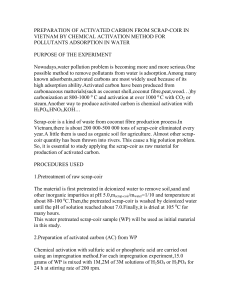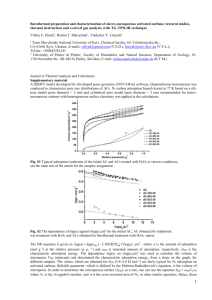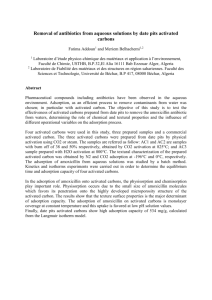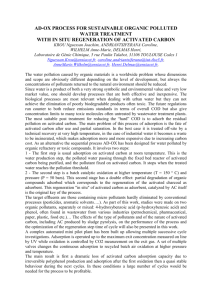Modification of a commercial activated carbon for metal adsorption
advertisement
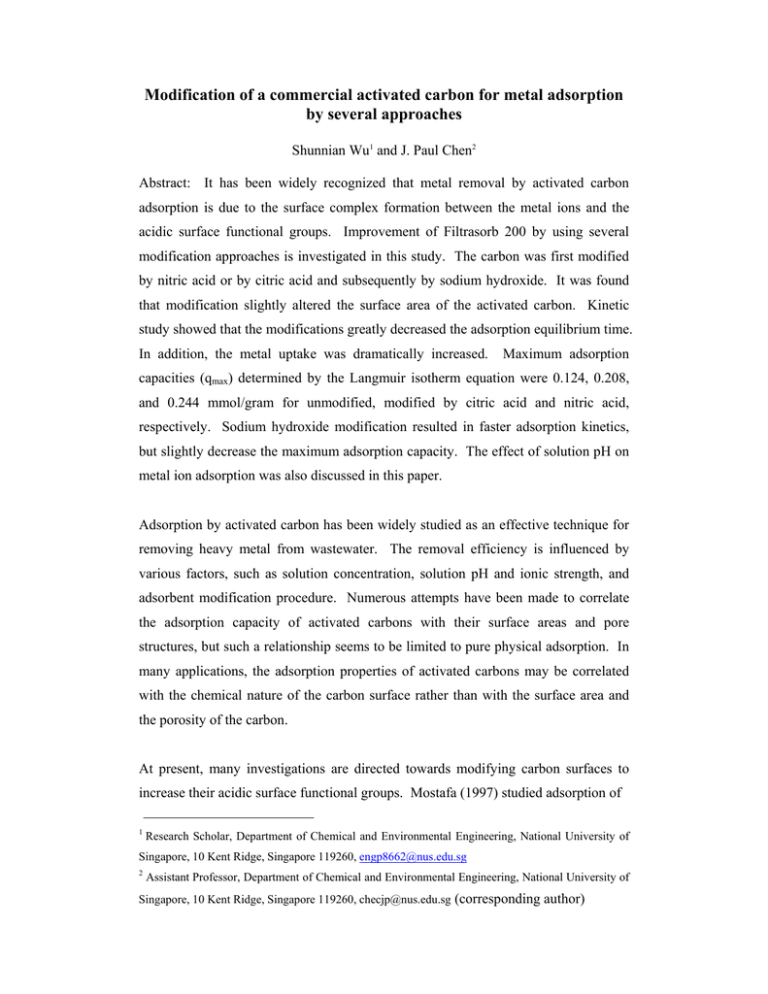
Modification of a commercial activated carbon for metal adsorption by several approaches Shunnian Wu1 and J. Paul Chen2 Abstract: It has been widely recognized that metal removal by activated carbon adsorption is due to the surface complex formation between the metal ions and the acidic surface functional groups. Improvement of Filtrasorb 200 by using several modification approaches is investigated in this study. The carbon was first modified by nitric acid or by citric acid and subsequently by sodium hydroxide. It was found that modification slightly altered the surface area of the activated carbon. Kinetic study showed that the modifications greatly decreased the adsorption equilibrium time. In addition, the metal uptake was dramatically increased. Maximum adsorption capacities (qmax) determined by the Langmuir isotherm equation were 0.124, 0.208, and 0.244 mmol/gram for unmodified, modified by citric acid and nitric acid, respectively. Sodium hydroxide modification resulted in faster adsorption kinetics, but slightly decrease the maximum adsorption capacity. The effect of solution pH on metal ion adsorption was also discussed in this paper. Adsorption by activated carbon has been widely studied as an effective technique for removing heavy metal from wastewater. The removal efficiency is influenced by various factors, such as solution concentration, solution pH and ionic strength, and adsorbent modification procedure. Numerous attempts have been made to correlate the adsorption capacity of activated carbons with their surface areas and pore structures, but such a relationship seems to be limited to pure physical adsorption. In many applications, the adsorption properties of activated carbons may be correlated with the chemical nature of the carbon surface rather than with the surface area and the porosity of the carbon. At present, many investigations are directed towards modifying carbon surfaces to increase their acidic surface functional groups. Mostafa (1997) studied adsorption of 1 Research Scholar, Department of Chemical and Environmental Engineering, National University of Singapore, 10 Kent Ridge, Singapore 119260, engp8662@nus.edu.sg 2 Assistant Professor, Department of Chemical and Environmental Engineering, National University of Singapore, 10 Kent Ridge, Singapore 119260, checjp@nus.edu.sg (corresponding author) mercury, lead and cadmium on activated carbon modified with sulphuric acid and observed a significant increase in metal ion adsorption. He proposed that sulphuric acid might introduce acidic surface oxides on the carbon surface. Toles et al. (1999) reported that air oxidation of phosphoric acid activated carbons yielded carbons with greater copper uptake. functional groups. Copper adsorption showed good correlation with surface Moreno-Castilla et al. (1997) claimed that modification of activated carbon with HCl, HF or HNO3, apart from removal of the mineral matter, introduced oxygen surface complexes that change the surface chemistry and can alter the surface area and porosity of the original samples. Modification of the surface chemistry of activated carbons might be a viable attractive route toward novel applications of these materials as adsorbent for heavy metal removal. In this paper, the commercial activated carbon Filtrasorb 200 was ground and sieved to obtain particles of size of 20-30 meshes. The carbon was washed with deionised water (DW-C) to remove impurity and potential powdered activated carbon. The yielded carbon was divided and chemically modified in different approaches: by reaction with 1M citric acid (CA-C) and subsequently with 1M sodium hydroxide (CA-SC), by oxidation with concentrated of nitric acid (NA-C) and subsequently by reaction with 1M sodium hydroxide (NA-SC). The porous structure characteristics and the pH values of aqueous suspensions of the carbon samples are summarized in Table 1. It shows that the surfaces of the modified carbon posses different chemical properties, but similar surface area (BET). It indicates that modification of activated carbon only slightly alters their porosity. Table 1. Surface characteristics of the carbons Carbon DW-C NA-C NA-SC CA-C CA-SC BET surface area (m2/g) 642 668 646 624 663 pH 6.88 3.74 8.49 3.58 8.79 Adsorption capacity (mmol/g) 0.124 0.244 0.227 0.208 0.179 Kinetic study of copper ion adsorption on the activated carbon samples is shown in Figure 1a and 1b. Most of the copper ion adsorption occurred at the first 2 hours, followed by a relatively slow adsorption process. The modified activated carbons demonstrate larger adsorption rate compared with unmodified carbon. It is observed that modification with sodium hydroxide resulted in further faster adsorption kinetics. By plotting log (%adsorption) vs. log (time) of the results, it is found that the obtained straight line deviates from the origin, which indicates that intraparticle transport is not the only rate limiting step. Probably, the transport of the copper ions from the solution through the particle solution interface into the pores of the particle as well as the adsorption on the available surface the carbons are both responsible for the uptake process. 60 a 100 b 50 80 q/qmax q/qmax 40 60 40 DW-C NA-C NA-SC 20 carbon: 5 g/L [Cu2+]0 = 1x10-4 M Ionic strength: 0.01 M 30 20 10 0 CA-SC CA-C Carbon 1.5 g/L [Cu2+]0 = 1x10-3M Ionic strength = 0.01 M 0 0 20 40 time, hour 60 80 0 2 4 6 8 10 Time, hour Figure 1 Kinetics of copper ion adsorption onto carbon The adsorption isotherm of copper ions onto various carbon samples in buffered solution with 0.03M acetic acid and 0.07M sodium acetate is shown in Figure 2. The Langmuir equation is employed and the calculated adsorption capacities are given in Table 1. Under the same conditions, the adsorption capacity decreases in the following manner: NA-C > NA-SC > CA-C > CA-SC > DW-C. Modification by nitric acid doubles the copper ion adsorption capacity. This is in consistence with the increase of surface acidic functional groups with oxidation of the carbon. Modification by citric acid increases the copper ion adsorption capacity more than 90%. This may be attribute to the increase of total negative charge on the carbon surface. It is noted that treatment of nitric acid or citric acid modified activated carbon with sodium hydroxide decreases the copper ion adsorption capacity. This result suggests that base treatment might destroy some surface acidic functional groups. However, the Langmuir equation does not fit the experimental results very well. On the contrary, the Freundlich equation gives a satisfactory fitting and the modelling result is shown in Figure 2. It supports that the surface of the carbons is heterogeneous and contains various functional groups. 0.25 Copper ion Removal percentage 110 q (mmol/g) 0.20 0.15 0.10 0.05 CA-C CA-SC NA-C NA-SC DW-C Freundlich modeling 0.00 0 10 20 30 40 50 100 90 80 70 60 DW-C Carbon: 5 g/L [Cu2+]0 = 1x10-4 mg/L Ionic strength: 0.01 M 50 NA-C NA-SC CA-C CA-SC 40 30 60 3 70 Figure 2 Adsorption isotherms of copper ions on carbon samples 4 5 6 7 8 Final solution pH Ce (mg/L) Figure 3 Effect of solution pH on copper ion adsorption Effect of pH on copper ion adsorption by carbon samples is shown in figure 3. With the increase of final solution pH, the copper ion removal increases. When NA-SC and CA-SC samples are applied, though initial solution pH changes from 2 to 7, final solution pH is kept at around 7.2. It suggests that treatment of nitric acid or citric acid modified activated carbon with sodium hydroxide, though decreases copper ion adsorption capacity, might obtain satisfactory removal effect by increasing solution pH. References: Mostafa MR (1997) “Adsorption of mercury, lead and cadmium ions on modified activated carbon”, Adsorption Sci. Technol., 15:551-557. Toles CA, Marshall WE and Johns MM (1999) “Surface functional groups on acidactivated nutshell carbons”, Carbon, 37:1207-1214. Moreno-Castilla C, Carrasco-Marin F, Maldonado-Hodar FJ and Rivera-Utrilla J (1997) “Effects of non-oxidant and oxidant acid treatments on the surface properties of an activated carbon with very low ash content”, Carbon, 36:145-151.



